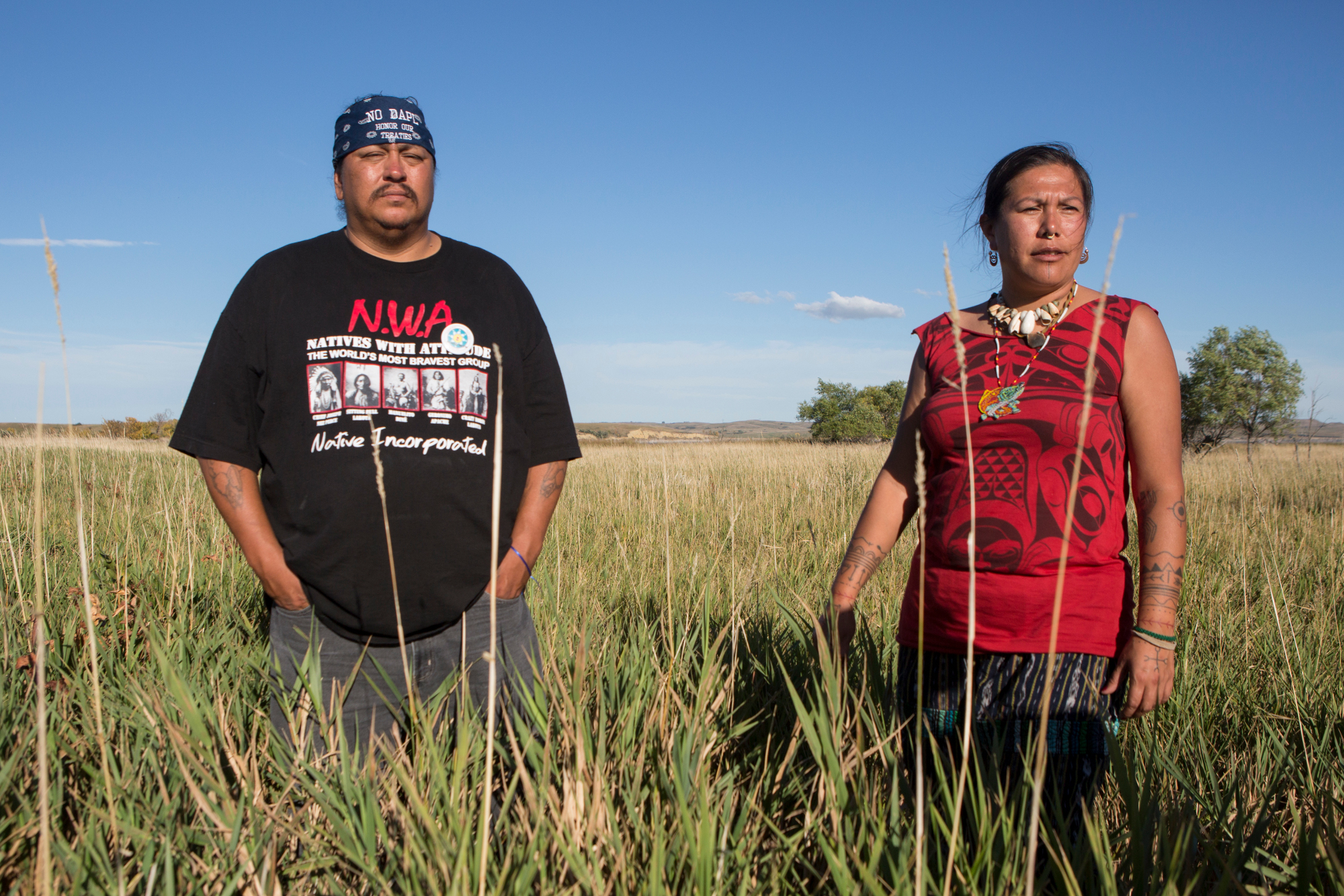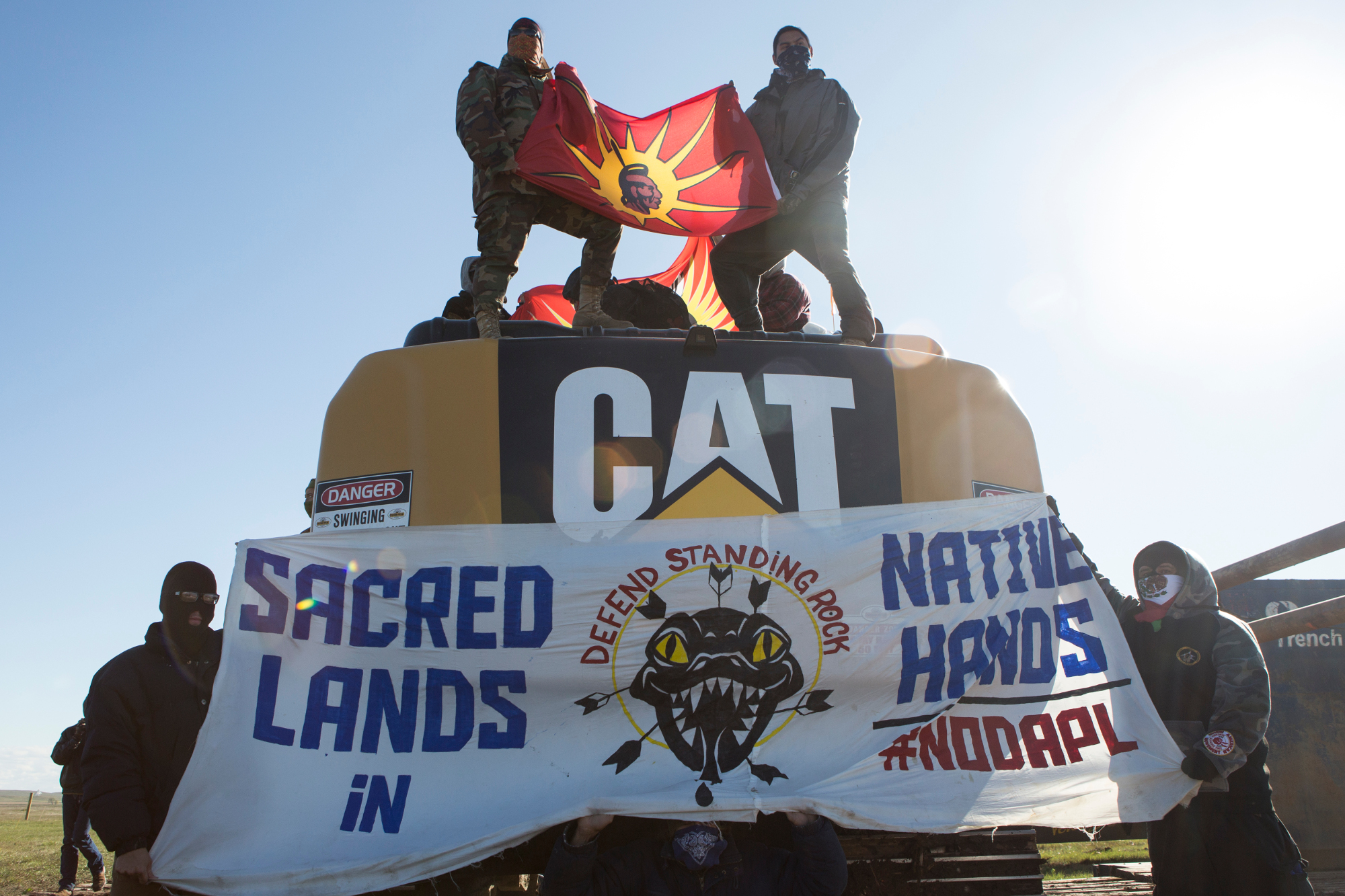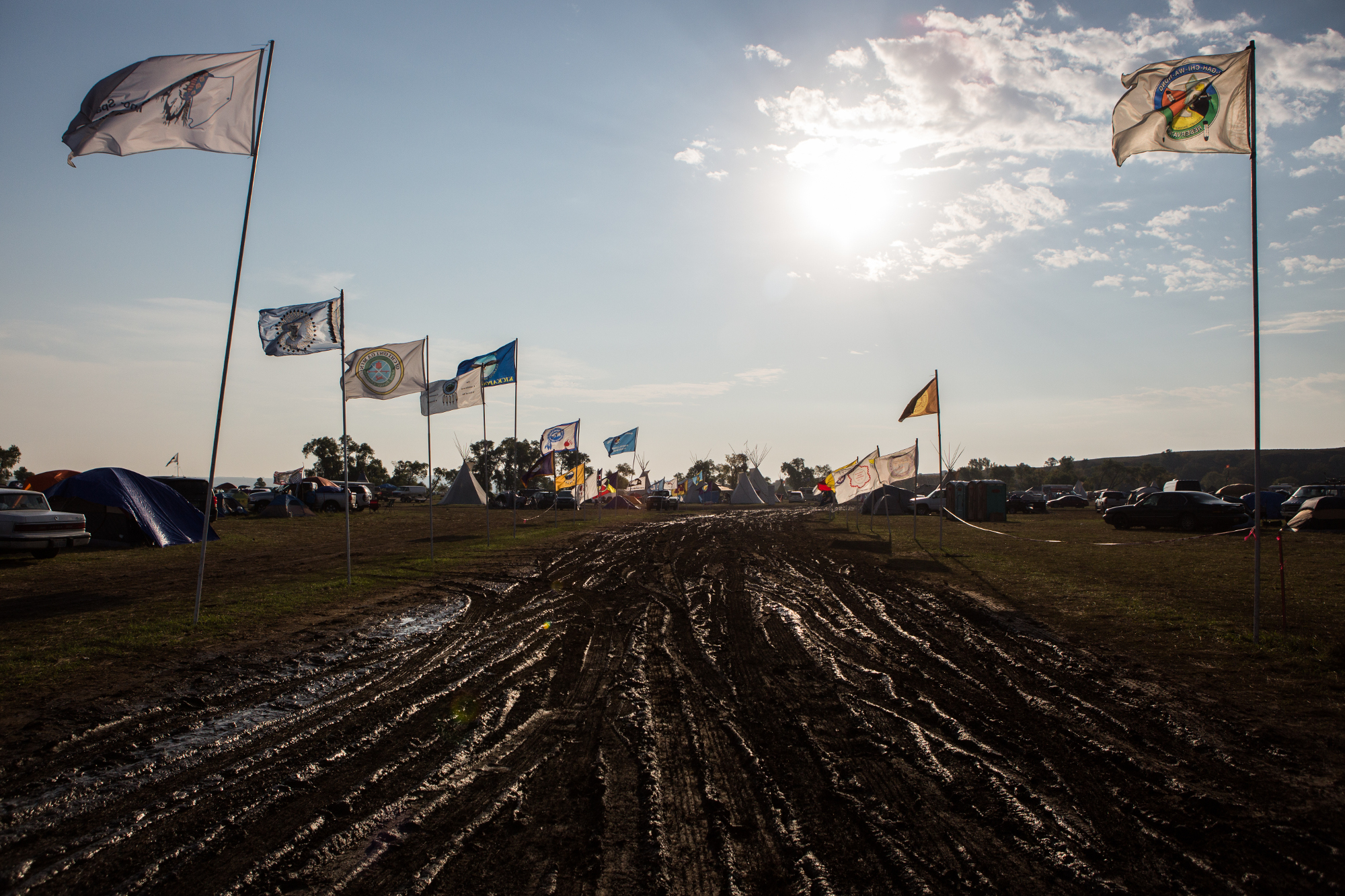Standing Rock: the story of a heroic resistance
- November 19, 2016
Land & Liberation
For nearly seven months, indigenous water protectors have been leading a heroic resistance to block the construction of the Dakota Access Pipeline.
- Author
The Standing Rock occupation is a movement based on presence. In taking space and time away from Energy Transfer Partners, from the Army Corps of Engineers, from Morton County, from North Dakota, from the United States of America, Standing Rock has come to embody the largest show of resistance in the United States since at least the Ferguson riots of 2014.
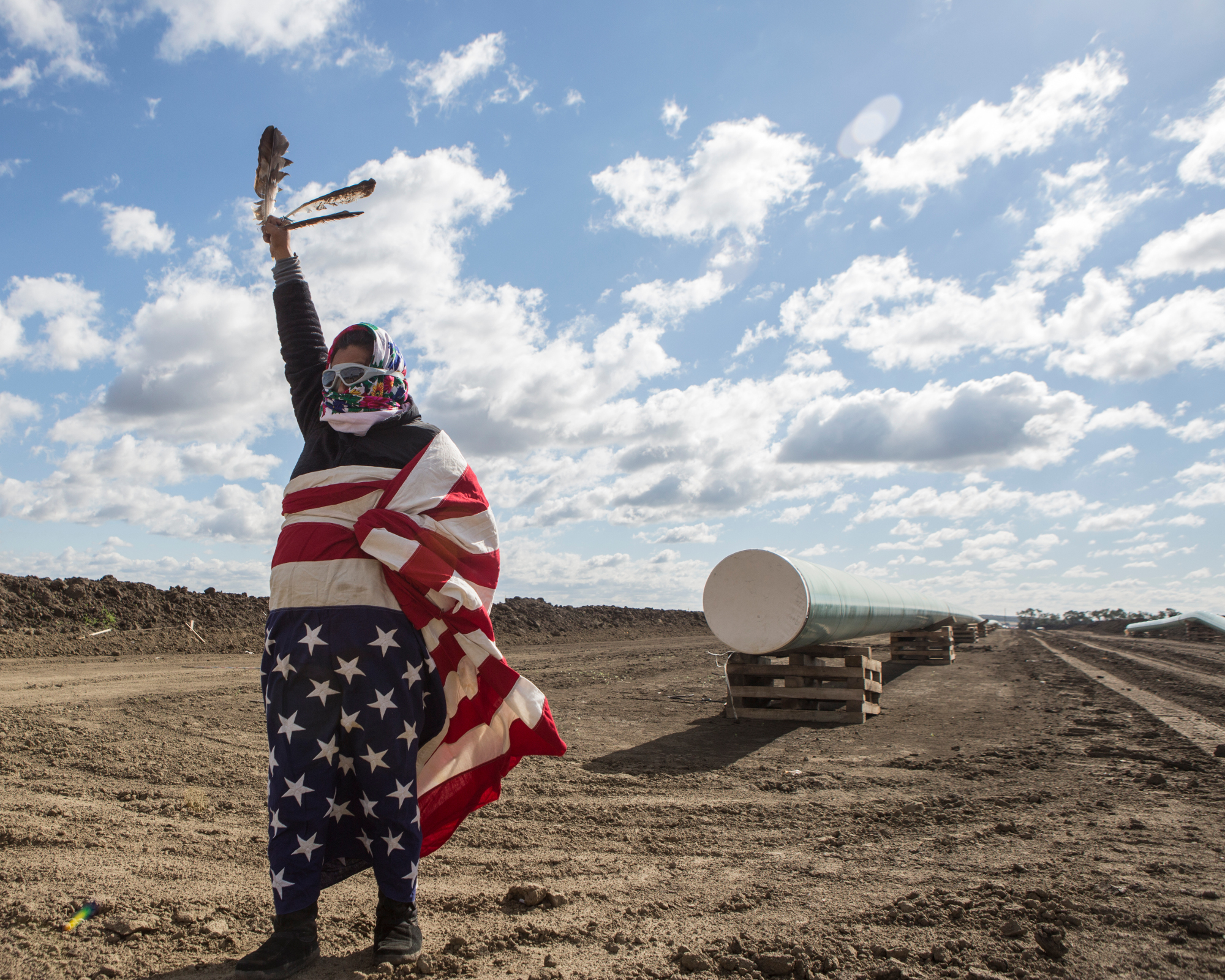 Like Ferguson, and before it the Wounded Knee occupation of 1973, the place itself has become shorthand for the movement: say “Standing Rock” and what comes to mind is encampments, lock-downs, blockades, and stand-offs aimed at preventing the construction of the Dakota Access Pipeline through the Missouri River.
Like Ferguson, and before it the Wounded Knee occupation of 1973, the place itself has become shorthand for the movement: say “Standing Rock” and what comes to mind is encampments, lock-downs, blockades, and stand-offs aimed at preventing the construction of the Dakota Access Pipeline through the Missouri River.
A New History
The now sprawling encampment of thousands, capturing the attention of millions around the world, had a fairly modest beginning. The Sacred Stone Camp was set up on April 1 by youth of the Standing Rock Indian Reservation as a prayerful vigil to watch for the beginning of construction of the Dakota Access Pipeline. The tribe had already been involved in a lawsuit to prevent construction of the pipeline for close to two years.
This initial camp is located on the reservation itself, close to the intersection of the Missouri and Cannonball Rivers. The meeting of the two rivers used to create a whirlpool, producing a uniquely shaped stone, from which the Sacred Stone Camp takes its name. The Army Corps of Engineers later altered the route of the river itself in the 1940s, flooding a portion of the reservation, destroying the whirlpool and the sacred stone with them. Throughout the spring and summer, the Sacred Stone Camp served both a site of constant prayer and as launching pad for a series of symbolic actions aimed at preventing the beginning of construction.
In late July, as the first signs of construction in the area became visible, the Standing Rock tribe formally invited the Oceti Sakowin — the seven council fires of the Lakota, Dakota, and Nakota peoples — and in particular the warriors of the Oglala Lakota band from the Pine Ridge Indian Reservation to join them in their stand. Many came to Standing Rock with their extended families directly from their annual Sundance ceremonies, so had already been camping out for up to a month before arriving.
At this time, the Standing Rock tribe and the Oceti Sakowin also called on other native nations and non-native allies to join the encampment in solidarity. As supporters began flooding into Sacred Stone, the Rosebud Camp was started nearby, also on the reservation but right off of Highway 1806. As yet more people arrived, an “overflow” camp was then established on the other side of the Cannonball River, which soon became home to thousands, becoming the main Oceti Sakowin Camp. It is located off reservation, officially on Army Corps of Engineers land, and thus is an illegal occupation and a direct action in itself. This encampment has become a direct challenge to the numerous treaty violations that have limited the sovereignty of the Lakota people solely to their federally managed reservations.
At this point, direct actions became an almost daily occurrence, as water protectors would march the short distance from the Oceti Sakowin Camp to active construction sites and disrupt them. Using tactics inherited from the environmental movement, water protectors began performing “lockdowns” — locking or chaining themselves to construction equipment to prevent its use.
This summer witnessed a number of historic events. The Crows, as well as other indigenous nations who had been historic enemies of the Lakota, arrived in procession to offer peace and join together to fight the pipeline. Soon, close to 300 federally recognized tribes had sent delegations and formally declared solidarity. By the beginning of September, the occupation’s population reached a high point of around 5,000 people.
It was at this point that mounting tensions came to a head, thrusting Standing Rock into the national media spotlight. DAPL began hiring a private security firm to stand guard over the construction sites and prevent disruption. As the long-standing lawsuit finally neared a court decision, the Standing Rock tribe filed documentation of archeological sites, including ancestral burial grounds, that existed along the proposed pipeline route. The next day, September 3, construction workers bulldozed an ancient burial ground described in those court documents.
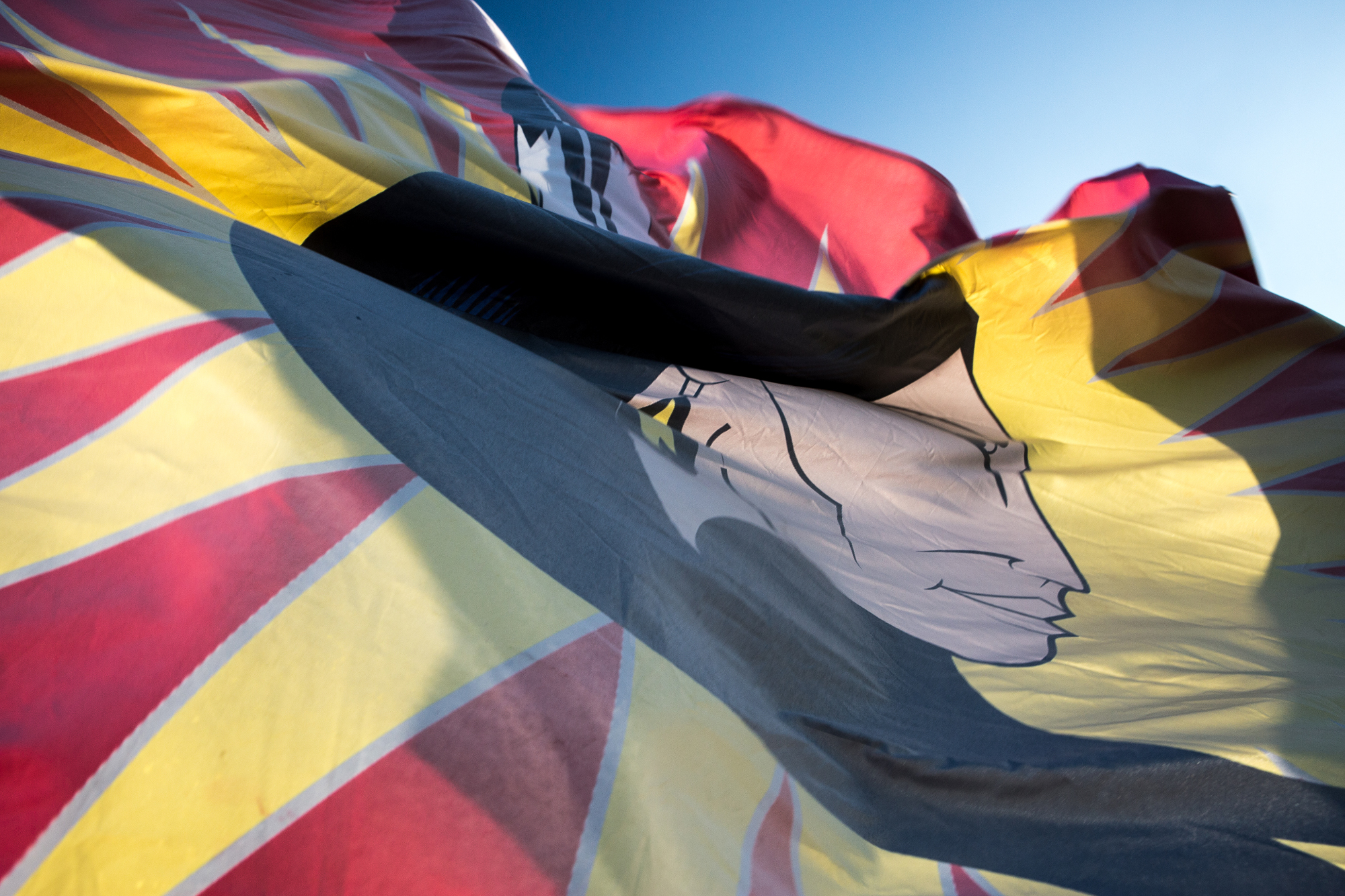 That afternoon, as hundreds marched along the highway to symbolically plant their respective nations’ flags on the proposed pipeline route, they found themselves confronted with the sight of this desecration. A group of women tore down the fence surrounding the construction site, and hundreds rushed in to block the bulldozers. As the construction workers retreated, the water protectors were confronted by a private security force. In the ensuing stand-off, water protectors were pepper sprayed, punched, tackled, and bitten by attack dogs. With the images that began to circulate, so eerily reminiscent of both the 1960s Civil Rights Movement as well as the 19th Century Indian Wars, all eyes were now on Standing Rock.
That afternoon, as hundreds marched along the highway to symbolically plant their respective nations’ flags on the proposed pipeline route, they found themselves confronted with the sight of this desecration. A group of women tore down the fence surrounding the construction site, and hundreds rushed in to block the bulldozers. As the construction workers retreated, the water protectors were confronted by a private security force. In the ensuing stand-off, water protectors were pepper sprayed, punched, tackled, and bitten by attack dogs. With the images that began to circulate, so eerily reminiscent of both the 1960s Civil Rights Movement as well as the 19th Century Indian Wars, all eyes were now on Standing Rock.
In the week that followed, the governor of North Dakota declared a state of emergency and called in the National Guard, who began manning a militarized checkpoint on the highway from state capital Bismarck to Standing Rock. A judge finally made a decision on the years-old lawsuit, ruling against an injunction on construction. Hours later, several branches of the Federal Government, including the Army Corps of Engineers, released a statement asking for a temporary, voluntary injunction on construction within 40 miles of the river. A smaller Front Line Camp, known as Sacred Ground Camp, was established along both sides of Highway 1806 at the site of this recent clash, monitoring the construction crews and keeping vigil over the exposed burial sites which would be disturbed by the pipeline.
To maintain momentum, the camp has continually innovated their tactics. With construction now taking place much further away from the camp, they began to stage lockdown actions at these now remote locations. Due to their distance, the secrecy involved in planning, and the particular skill set required, these actions were such that only a small, specialized segment of the camp could participate in them. After one resulted in a mass arrest, they quickly lost favor, and there was a lull in action for nearly a fortnight. To recapture the mass participation of earlier actions, they began to organize caravans of dozens of cars, trucks and buses, with several hundred people gathered within them, to shut down active construction sites upwards of an hour’s drive from the encampments.
From late September to late October, these caravan blockades became a nearly daily occurrence. DAPL workers would leave the construction as soon as, if not before, protesters arrived. These protests revolved around ceremonies and prayers involving the planting of sacred corn or willow trees. They were tightly organized affairs, formally led by tribal elders, but with the full participation of the young and the old, men and women alike. The youth would be the first to arrive on the scene and would sometimes damage and spray paint construction equipment, before the elders arrived to command ceremony. As police began to respond in a more militarized way, and mass arrests began to happen again, the caravans began to simply drive slowly by construction sites, causing the workers to leave but without the risk of arrest.
Despite the constant interruptions of work, by late October DAPL construction was once again nearing the Missouri River, and was now almost complete. Citing the Fort Laramie treaties, the Oceti Sakowin declared eminent domain and occupied a stretch of the pipeline route. The Frontline Camp, located on what was officially DAPL property, was transformed from a small outpost to an encampment of hundreds. Barricades were put up on Highway 1806, and for nearly a week the eviction of the Frontline Camp seemed imminent. As tensions mounted, water protectors agreed to take down their barricades, but continued to maintain a check point along the highway.
On October 27, Morton County Sheriff’s Department, along with the National Guard and police departments from five other states, moved to evict the Frontline Camp. In a show of force, they arrived with armed vehicles, an LRAD sound cannon and riot gear. To block the police’s entrance into the camp, people abandoned their own cars in the middle of the street, slashed their tires and removed their license plates. Others locked themselves to a truck. Barricades were erected and set aflame on Highways 1806 and 134. As the camp was eventually raided, new barricades were set up at the intersection of the two highways and on a bridge further south. In the midst of the chaos, construction equipment and several police vehicles were torched.
In the weeks since, dramatic standoffs between water protectors and riot police deploying tear gas and rubber bullets have occurred regularly, as construction moves closer and closer to the river.
As Movement
The Standing Rock occupation is a movement based on presence, and by creating a new communal life of refusal on traditional Oceti Sakowin lands it challenges the historical progressions which got us here: the Louisiana Purchase of 1803; the violation of the Fort Laramie Treaties of both 1851 and 1868; the incorporation of the Dakota Territory in 1861; North Dakota’s admittance to the union in 1889; and Standing Rock’s formalization into a separate reservation cut off from the rest of the Great Sioux Nation.
With the occupation and its surrounding movement, these histories can be opened up to contemporary scrutiny and, more importantly, contestation. The struggles over the sovereignty of this land plays out in one way in the jurisdictional disputes, where you can see various departments of county and state police, the National Guard and private security companies called in to defend the so-called public and private properties being dug up to construct the DAPL. In late-September, Standing Rock Chairman Dave Archambault II even took the issue to Geneva to address the United Nations Human Rights Council about the abuses and violations taking place on treaty lands. These efforts and counter-responses are indicative of the complex nexus of local, state, federal, private and international forces and zones that indigenous peoples have found themselves in when arguing for and defending their sovereignty.
While the movement at Standing Rock draws on its own particular lineage and experience of struggle, it shares many of the signposts of recent global uprisings. Infrastructural development has often become both the object and site of struggle; the encampment and the blockade become primary among an arsenal of possible tactics and responses. The antagonists tend to be defined by being largely superfluous to the needs of capital, but who remain dependent on the market for their own reproduction. The encampment and blockade then create a rupture within the normalized experience of day-to-day life, and the experience of being within the camp becomes a laboratory to experiment with new forms of living together.
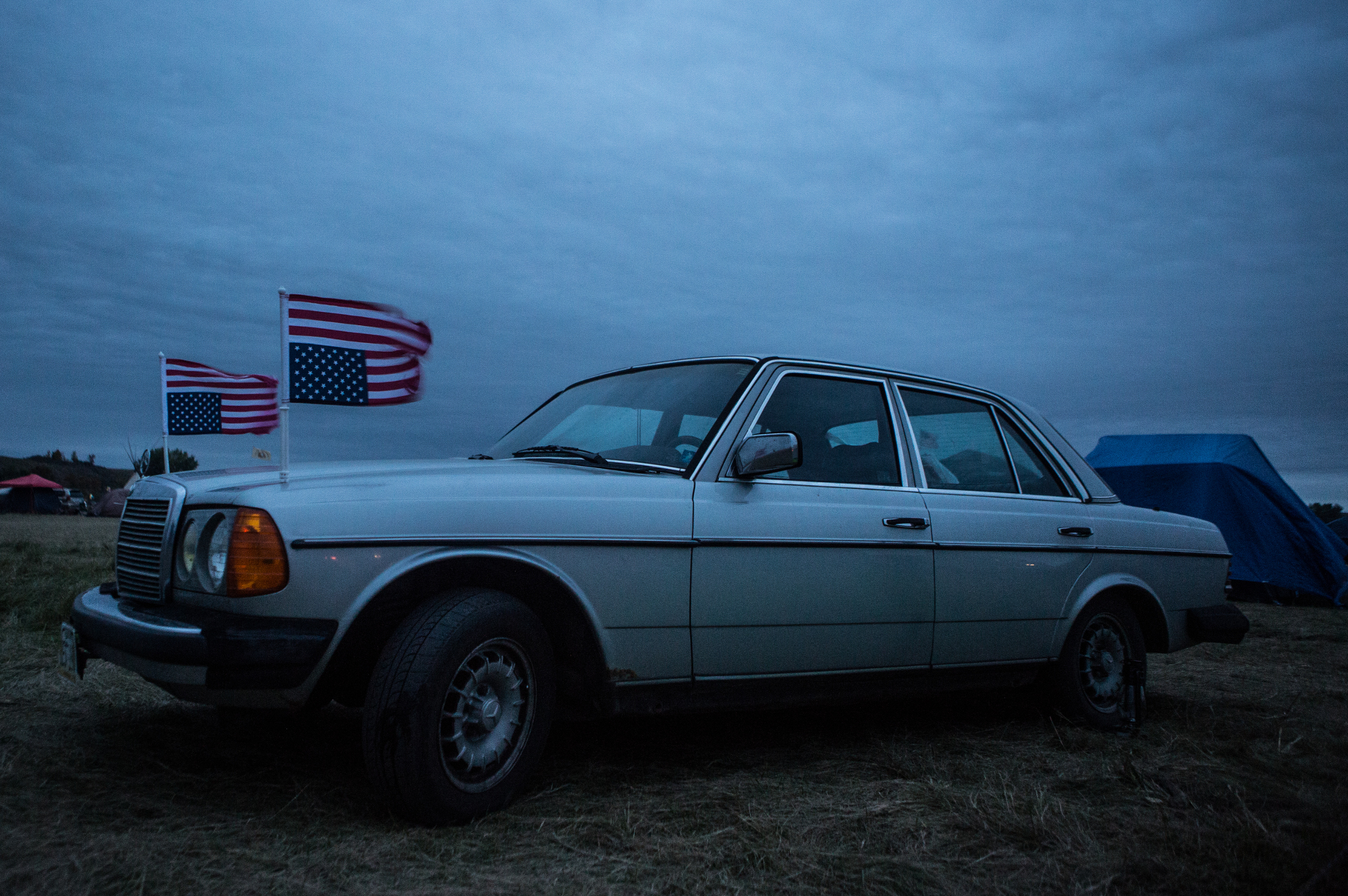 Social movements of the past, non-native and native alike, were often rooted in a particular community and territory — a dense social fabric that one largely lived one’s entire life within, reproducing itself through a set of cultural, spiritual, political and familial institutions. They were able to present a coherent world within and against the world they opposed. This allowed for traditions of struggle to be passed down through generations, and created a certain moral obligation to participate. It also provided a coherent vision for another kind of life and a world beyond capitalism. The history of the past half-century is the story of the dismantling of the possibility of these worlds. The strength of the Standing Rock Occupation is its ability to simultaneously remember and create its own potential as a community-in-struggle.
Social movements of the past, non-native and native alike, were often rooted in a particular community and territory — a dense social fabric that one largely lived one’s entire life within, reproducing itself through a set of cultural, spiritual, political and familial institutions. They were able to present a coherent world within and against the world they opposed. This allowed for traditions of struggle to be passed down through generations, and created a certain moral obligation to participate. It also provided a coherent vision for another kind of life and a world beyond capitalism. The history of the past half-century is the story of the dismantling of the possibility of these worlds. The strength of the Standing Rock Occupation is its ability to simultaneously remember and create its own potential as a community-in-struggle.
While the actions protesting the pipeline construction have become increasingly visible in the media, what’s less apparent are the generational, spiritual and territorial connections and contexts that animate this movement. It is the continued bonds of the Oceti Sakowin and the potency of their worldview that creates the foundation for what we now know as Standing Rock to exist at all, and it this that allows for the consistency, duration and persistence that has kept the occupation going for seven months.
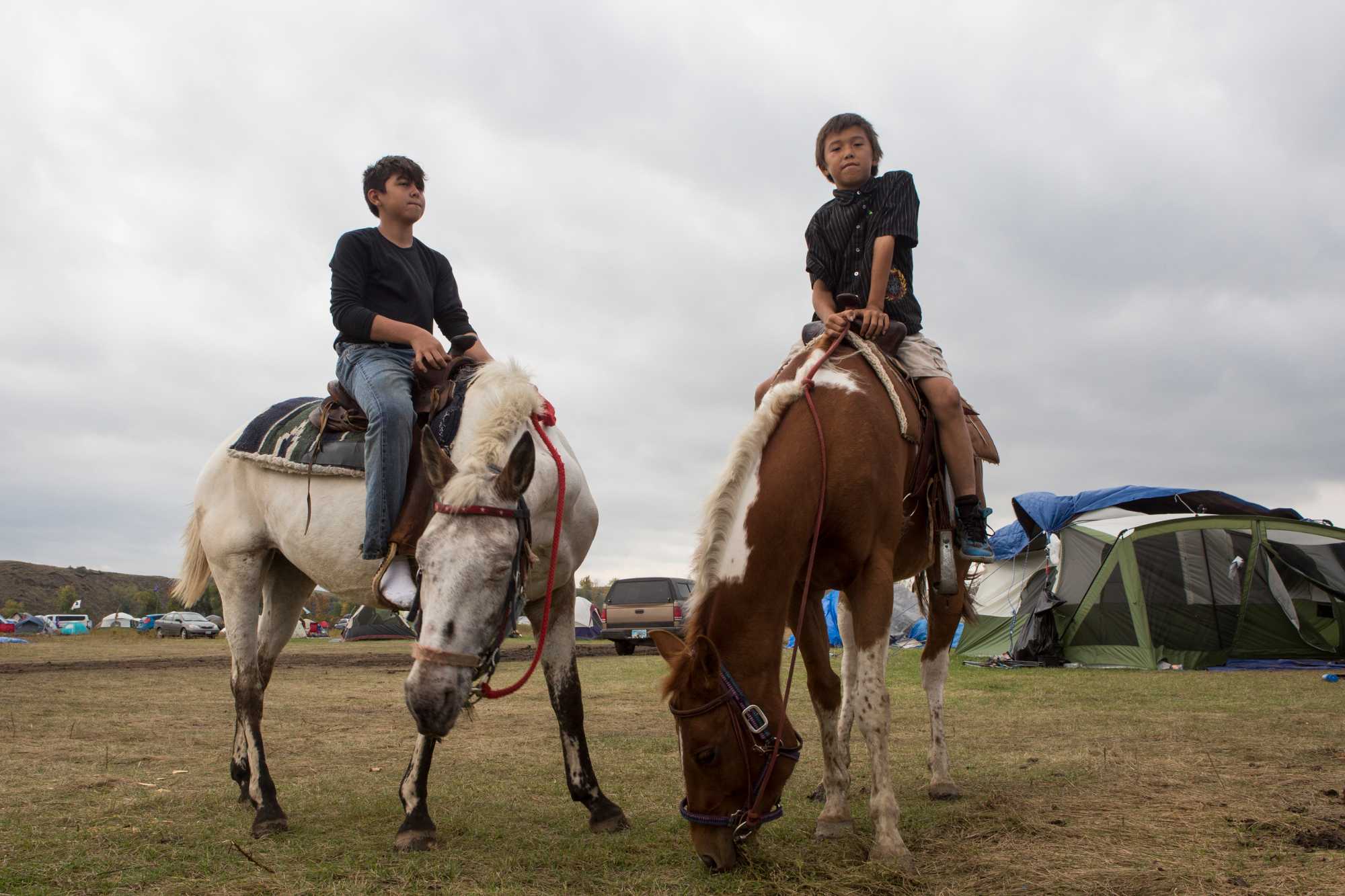 The politics demonstrated within the occupation of Standing Rock are not based around decisions but rather commitments. In representative liberal society, decisions are made by few, affect many, and their legitimacy comes with the tacit expectation that their results will be accepted and enacted. Commitments, however, need to be made by everyone. A movement like Standing Rock, centered around duration, depends on the commitment of all those present, across days, weeks, months. This in itself guarantees its communal form: the movement exists as long as those commitments exist, which rely on the spirit of the encampments themselves to bind people together.
The politics demonstrated within the occupation of Standing Rock are not based around decisions but rather commitments. In representative liberal society, decisions are made by few, affect many, and their legitimacy comes with the tacit expectation that their results will be accepted and enacted. Commitments, however, need to be made by everyone. A movement like Standing Rock, centered around duration, depends on the commitment of all those present, across days, weeks, months. This in itself guarantees its communal form: the movement exists as long as those commitments exist, which rely on the spirit of the encampments themselves to bind people together.
Unlike a political mobilization, wherein people are simply called upon to act together, in Standing Rock the participants have to live together as well. And not just for some days or even weeks, but now coming on seven months. The spaces of the camps themselves — as Standing Rock is made up of not one but many separate and autonomous mini-camps — have had to find ways to live and fight together, and the protracted nature of the movement necessitates that the daily reproduction required to materially and spiritually maintain the inhabitants of the camp inform the content and strategy of the struggle itself.
Those Gathered
You can see three categories among the inhabitants of the Standing Rock occupation. At its core are those from the Oceti Sakowin, which includes those directly from what is now the Standing Rock Indian Reservation, as well as the nearby reservations which once made up the Great Sioux Nation, including Cheyenne River, Pine Ridge, Rosebud, Crow Creek, Lower Brule, etc. For them the specificity of the land itself, its hills, caves, valleys, and rivers are of primary importance, and each carry a specific historical and contemporary meaning and purpose. The Standing Rock occupation, it is said, is the first council-wide gathering of the Oceti Sakowin since the Sioux Wars more than a hundred years ago.
 A second category of participation and solidarity are the indigenous peoples of Turtle Island, or North America, who have sent delegations and representatives from all over the continent, in what is the largest gathering of native tribes and peoples since colonization. This display of material solidarity and commitment is a focal point of the occupation, with the main boulevard lined with hundreds of flags of tribal nations who have visited. Flags are used throughout the encampments to demarcate space, and give visual representation and tribute to those who are embodying the fabric of this new community. As the movement’s tactics shifted at the end of September towards caravan actions to block the construction, participants were encouraged to bring their prayers, drums and flags, as a tribute to the vitality of this inter-tribal solidarity within the #NoDAPL movement. This could develop an ongoing consistency and momentum in its own right, beyond the occupation and this particular pipeline.
A second category of participation and solidarity are the indigenous peoples of Turtle Island, or North America, who have sent delegations and representatives from all over the continent, in what is the largest gathering of native tribes and peoples since colonization. This display of material solidarity and commitment is a focal point of the occupation, with the main boulevard lined with hundreds of flags of tribal nations who have visited. Flags are used throughout the encampments to demarcate space, and give visual representation and tribute to those who are embodying the fabric of this new community. As the movement’s tactics shifted at the end of September towards caravan actions to block the construction, participants were encouraged to bring their prayers, drums and flags, as a tribute to the vitality of this inter-tribal solidarity within the #NoDAPL movement. This could develop an ongoing consistency and momentum in its own right, beyond the occupation and this particular pipeline.
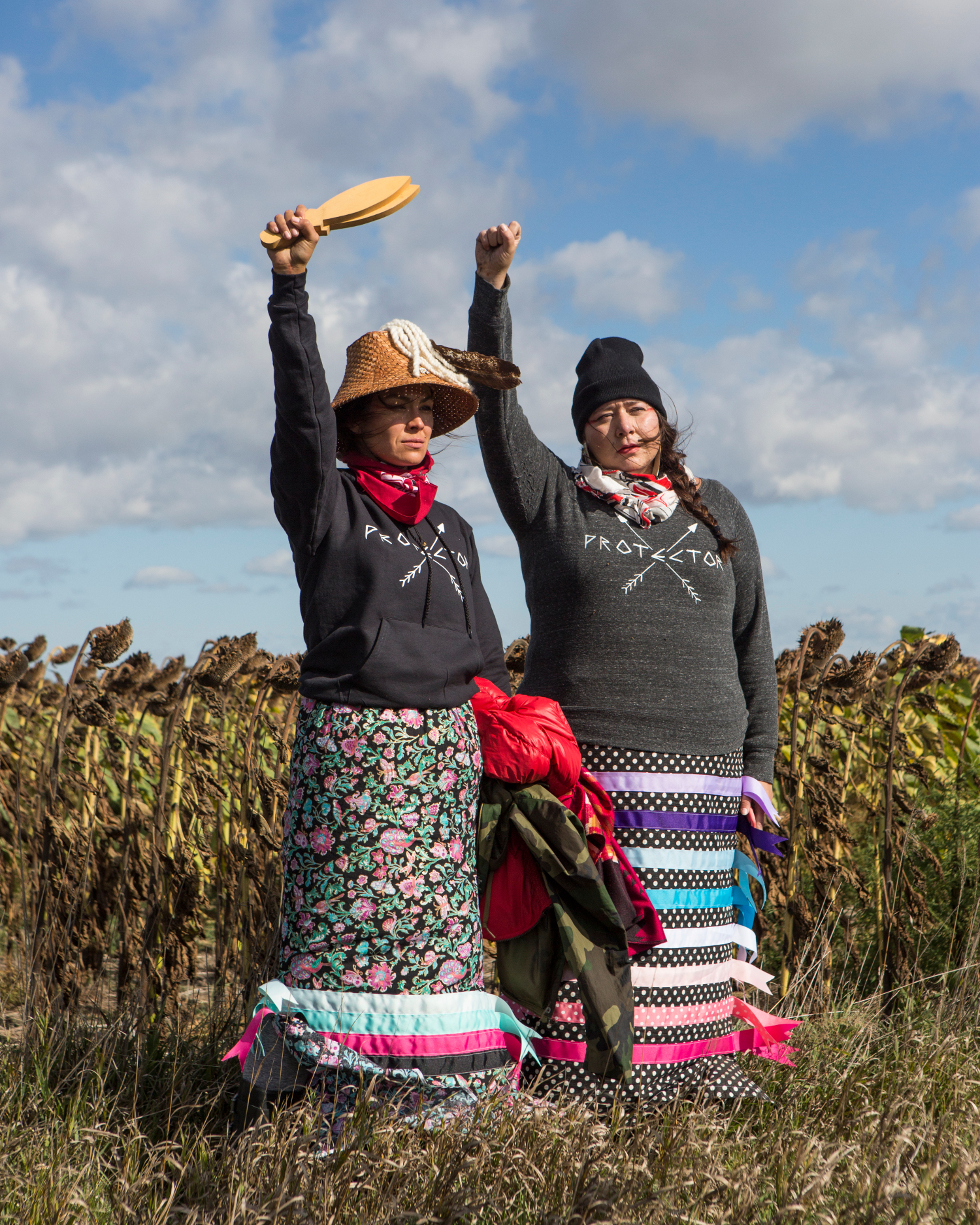 A third level of participation would be all of the non-native solidarity activists who have traveled to Standing Rock to offer their support. These have typically been those inspired by an opposition to the pipeline out of a concern for the environment, and could include New Agers and hippies to independent media activists to anarchists. More broadly, people have been showing up to Standing Rock from places ranging from the Amazon, the Arctic and Palestine. It has been said that Standing Rock is the largest-ever gathering of native and non-native peoples together for a common cause, which is also one of the factors attributed to the success and longevity of the movement, prioritizing an openness to encounter and solidarity.
A third level of participation would be all of the non-native solidarity activists who have traveled to Standing Rock to offer their support. These have typically been those inspired by an opposition to the pipeline out of a concern for the environment, and could include New Agers and hippies to independent media activists to anarchists. More broadly, people have been showing up to Standing Rock from places ranging from the Amazon, the Arctic and Palestine. It has been said that Standing Rock is the largest-ever gathering of native and non-native peoples together for a common cause, which is also one of the factors attributed to the success and longevity of the movement, prioritizing an openness to encounter and solidarity.
What’s remarkable about the Standing Rock Occupation is that it is not a typical political mobilization in New York, Washington, DC, or some other major American metropolis, with sizable populations already present. It is taking place in America’s fourth least populous state, an hour’s drive from the capital city, Bismarck, whose population is 61,000. Standing Rock is 900 miles from Chicago, 1,500 miles from Los Angeles, and 1,600 miles — or a 30-hour drive – from New York City, which is to say that the thousands who have circulated through the occupation these last months have likely traveled at great distance and expense to join the movement.
Mapping the Site
Spread out along Highway 1806 are the four separate camps that make up the occupation: Sacred Stone, Rosebud, Oceti Sakowin and Sacred Ground. At any given time, these camps are the home to 1,000 to 3,000 people, reaching a height of 5,000 in early September.
Oceti Sakowin, the main camp and by far the largest, approximates a small town with a grid of dirt roads, neighborhoods and rudimentary infrastructure. The main thoroughfare leading into the camp from the highway is lined with the flags of the close to three hundred tribal nations that have arrived to show solidarity. At the heart of the camp is its sacred fire, host to a constant procession of ceremonies, dances, performances, speeches and speak-outs, and a massive communal kitchen offering daily meals.
The camp now hosts an elementary school, a pirate radio station, an independent media center, a solar-powered station for charging phones and equipment, a voluntary security force organized by the American Indian Movement, a first aid station, tents offering massages, herbal medicine and herbal teas, a lacrosse field, several dozen tents distributing food, camping gear, and clothes, and dozens of portapotties, dumpsters and water tanks. There are around a dozen sweat lodges through the camp, and half a dozen horse stables. There is a horse-based messenger system, and at one point there was a race track set-up. There is a natural birth doula group at the camp that has facilitated at least one birth so far. There’s a system of trucks that distribute fire wood, produce and other supplies throughout the smaller camps. There is also a minor fleet of motorboats and canoes.
The Oceti Sakowin Camp itself is composed of dozens of constituent camps that might constitute a tribal, familial or affinity-based delegation, each built around a communal fire and kitchen. These camps-within-the-camp are autonomous and self-reproducing, and the encampments themselves have come to re-create the bare essences of human settlement. The lines are blurred between them making up a home or a village within the larger encampment: one could read the tents as individual rooms and the campfire a common area in what is essentially a unitary home; or that the tents themselves are homes, and the campfire becoming a small village square.
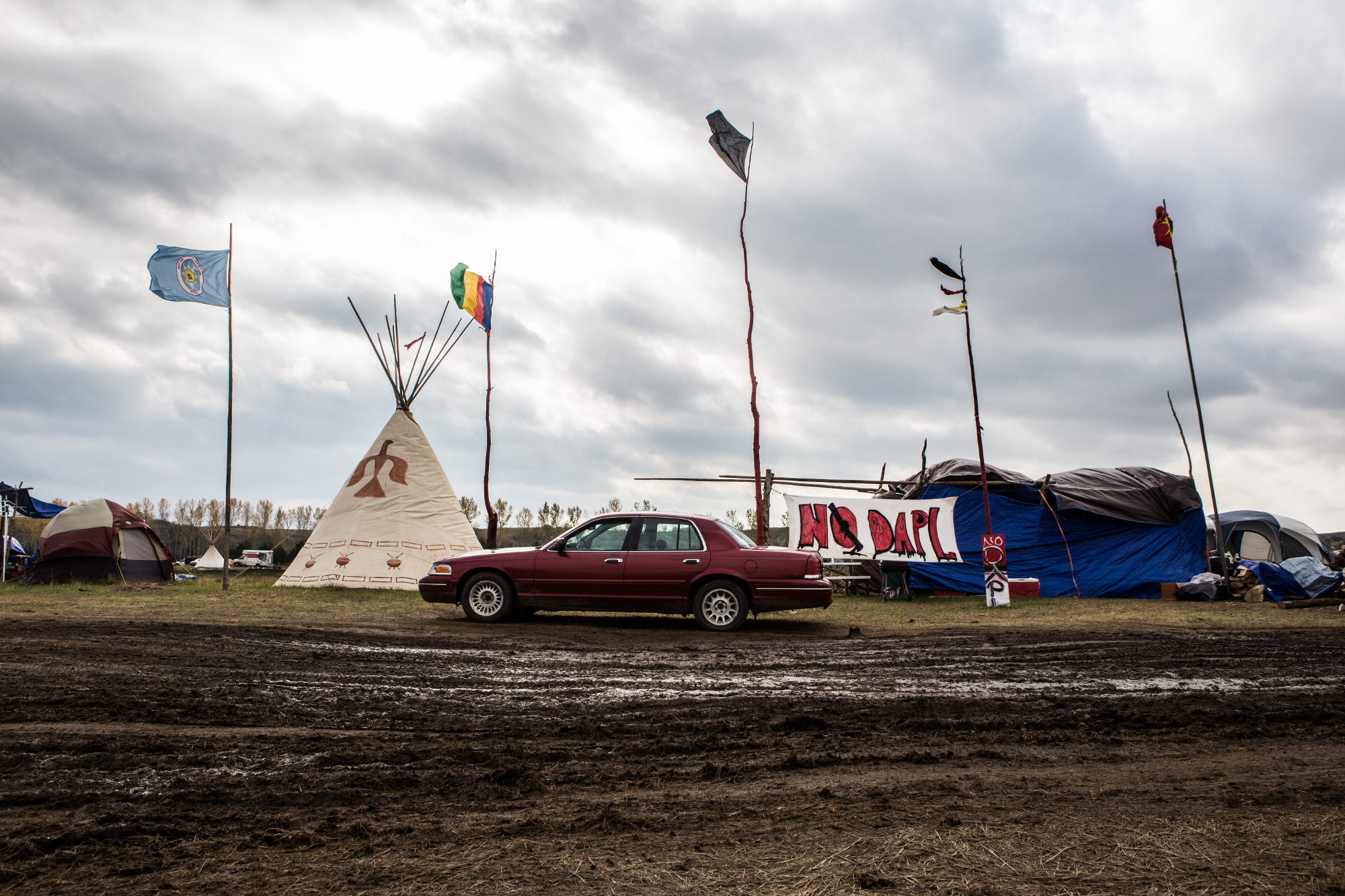 The Red Warrior Camp, known for its participants’ active participation and planning many of the direct actions in the movement, is a camp within Oceti Sakowin towards the back, right along the Cannonball River. It has its own fence surrounding it, with its own security, fire pit, supply tents, communal kitchen, daily meals, dining and meeting areas in large army tents, a library, screen-printing lab, sewing machines, and a scout-tent monitoring and mapping the construction. Adjacent to Red Warrior is a Haudenosaunee mini-camp, for Six Nations Confederacy peoples from so-called Quebec, Ontario and New York, with their own fire, meals, supplies, etc. Nearby is also a Two Spirits Camp. Such mini-camps proliferate throughout Oceti Sakowin and Standing Rock, speaking to the multiplicity within the movement.
The Red Warrior Camp, known for its participants’ active participation and planning many of the direct actions in the movement, is a camp within Oceti Sakowin towards the back, right along the Cannonball River. It has its own fence surrounding it, with its own security, fire pit, supply tents, communal kitchen, daily meals, dining and meeting areas in large army tents, a library, screen-printing lab, sewing machines, and a scout-tent monitoring and mapping the construction. Adjacent to Red Warrior is a Haudenosaunee mini-camp, for Six Nations Confederacy peoples from so-called Quebec, Ontario and New York, with their own fire, meals, supplies, etc. Nearby is also a Two Spirits Camp. Such mini-camps proliferate throughout Oceti Sakowin and Standing Rock, speaking to the multiplicity within the movement.
Spatially and organizationally within the Standing Rock Occupation there is no one camp, no one assembly, or fire, or meal, or decision-making body or administration — and this should be seen as one of its strengths. The historic and unprecedented gathering of peoples that make up Standing Rock have found a way to live and fight together while acknowledging and respecting the differences and needs that each brings to the moment
Temporality and the DAPL
One of the distinct markers of the Standing Rock Occupation is its familial basis and the generational interconnectedness that makes up the encampments and movement itself. It is not at all uncommon to see, for example, a mini-camp anchored by a matriarch in her sixties, often with direct experience from the American Indian Movement of the 1970s. She could be camping with her children in their forties, the AIM equivalent of Black Panther “cubs,” who will have grown up in a radical household oriented towards organizing politically to reclaim traditional ways of life and upbringing.
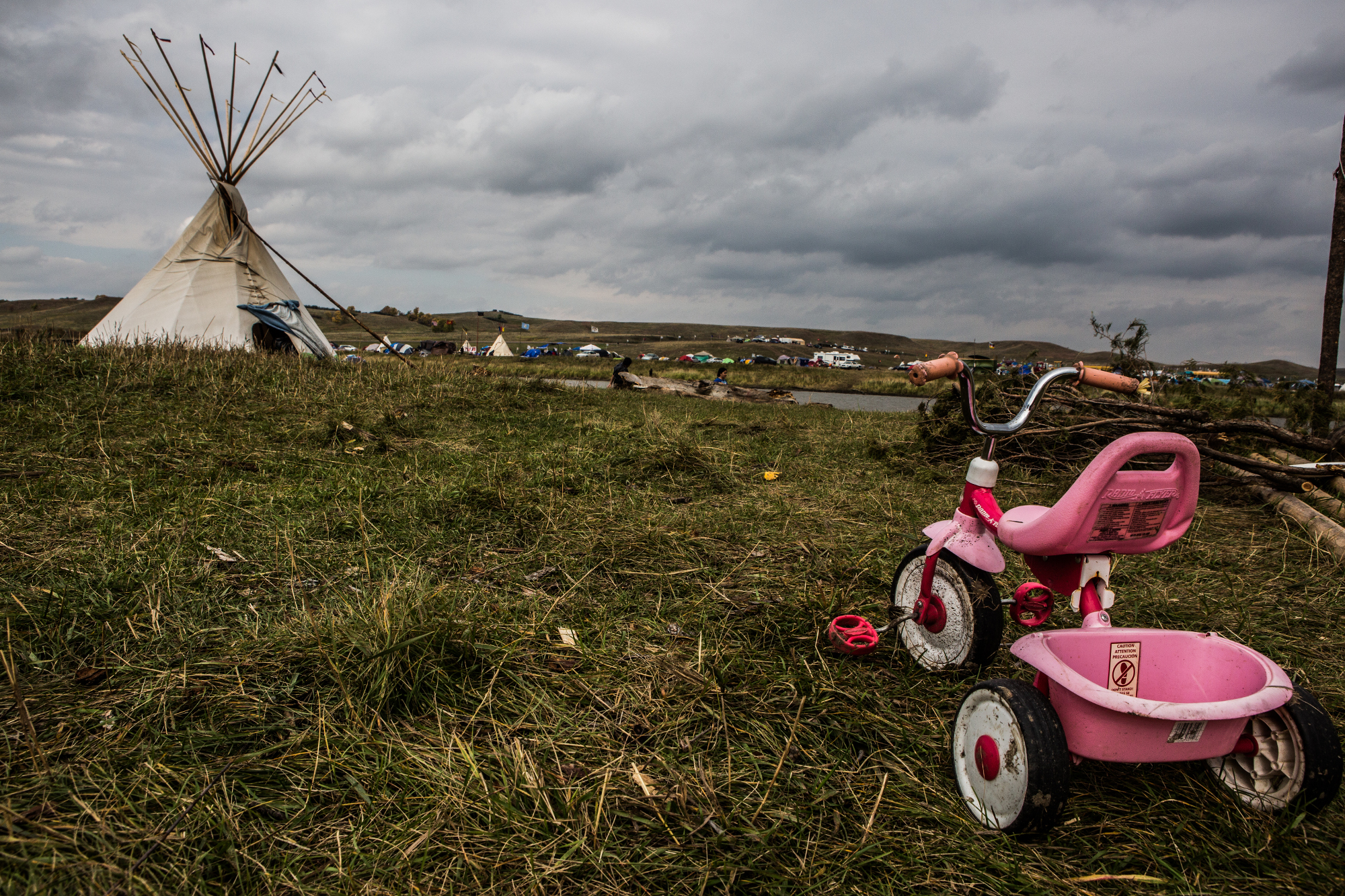 This generation, those born in the late 1960s and 70s, are often respected leaders within the movement, while their children, nieces and nephews in their twenties are the active warriors or volunteers on the front-lines of the protests. Then their young children or grandchildren might be seen playing and running around the camps, or now attending the school that was started for those who moved to the camps full-time with their children. This alone would be four generations, and of course within each of these camps are extended families and relations present, tiospaye in Lakota, who often refer to one another respectfully and intimately as sister, cousin, aunt or grandmother. These familial connections are rooted within a broader individual and social understanding of self within a structure of a clan, community and nation. This is to say that within the culture of the Standing Rock Occupation there are sets of relations and obligations outside of the flattening logic of citizenship, which has come to mean an empty equality of individuals lacking broader ties, responsibilities or shared histories.
This generation, those born in the late 1960s and 70s, are often respected leaders within the movement, while their children, nieces and nephews in their twenties are the active warriors or volunteers on the front-lines of the protests. Then their young children or grandchildren might be seen playing and running around the camps, or now attending the school that was started for those who moved to the camps full-time with their children. This alone would be four generations, and of course within each of these camps are extended families and relations present, tiospaye in Lakota, who often refer to one another respectfully and intimately as sister, cousin, aunt or grandmother. These familial connections are rooted within a broader individual and social understanding of self within a structure of a clan, community and nation. This is to say that within the culture of the Standing Rock Occupation there are sets of relations and obligations outside of the flattening logic of citizenship, which has come to mean an empty equality of individuals lacking broader ties, responsibilities or shared histories.
 The Lakota will often speak of “the seven generations,” meaning a framework to think of oneself within a continuum of both those who have come before, as well as those still to come. This could be yourself, three generations before and three generations forward. Or yourself and your grandchildren’s grandchildren, which is to say, those you will necessarily never meet. So each decision or action taken by yourself, your tiospaye, or nation should be measured as to how it would relate not just yourself or the present, as in liberal society, but for each of these generations. When such an ethical and historical worldview is applied to a territory, the question becomes not just about protecting the Great Sioux Nation or the Missouri River today, but thinking what would be required to maintain their continued potentialities for the seven generations, for your grandchildren’s grandchildren.
The Lakota will often speak of “the seven generations,” meaning a framework to think of oneself within a continuum of both those who have come before, as well as those still to come. This could be yourself, three generations before and three generations forward. Or yourself and your grandchildren’s grandchildren, which is to say, those you will necessarily never meet. So each decision or action taken by yourself, your tiospaye, or nation should be measured as to how it would relate not just yourself or the present, as in liberal society, but for each of these generations. When such an ethical and historical worldview is applied to a territory, the question becomes not just about protecting the Great Sioux Nation or the Missouri River today, but thinking what would be required to maintain their continued potentialities for the seven generations, for your grandchildren’s grandchildren.
The Lakota have also spoken often of a prophecy of a black snake, wherein a great snake will come and bring with it incomprehensible destruction. In recent years this was interpreted as the proposed Keystone Pipeline, which was also slated to be built through Oceti Sakowin territory, before a large movement led to Obama rejecting the final phase of its construction in November 2015. Since then the prophecy has been taken to speak to any number of existing and proposed pipelines, and in August Iyuskin American Horse of Standing Rock wrote in The Guardian:
Our elders have told us that if the zuzeca sape, the black snake, comes across our land, our world will end. Zuzeca has come — in the form of the Dakota Access Pipeline — and so I must fight… We are not protesters. We are protectors. We are peacefully defending our land and our ways of life. We are standing together in prayer, and fighting for what is right. We are making history here. We invite you to stand with us in defiance of the black snake.
Many within the Standing Rock Occupation, in particular within the Red Warrior Camp, have taken to call themselves “Black Snake Killas,” stenciling this slogan on their camouflaged jackets, and it has become a consistent battle cry within the movement.
“Bring Your Prayers”: Prayer as a Method of Protest
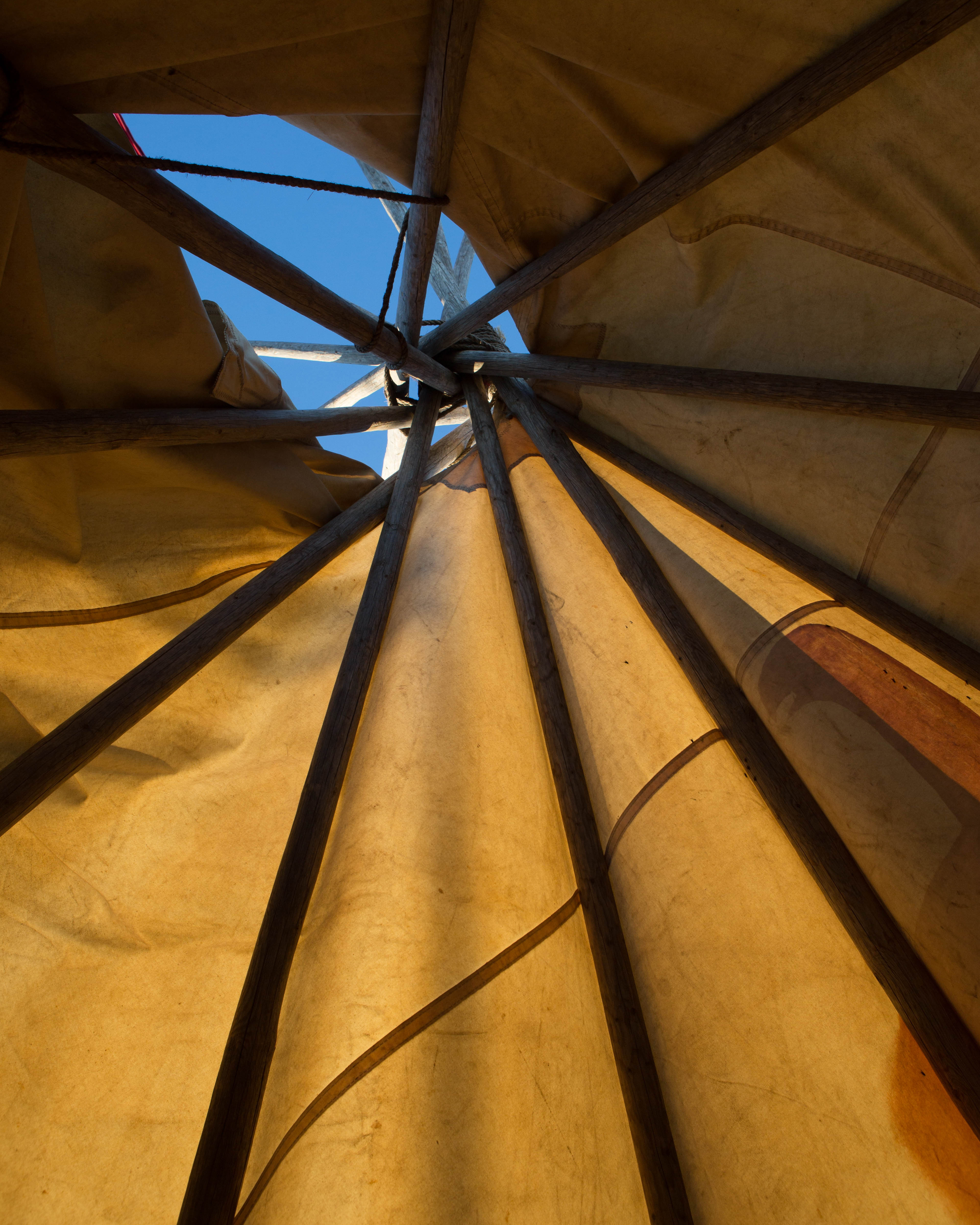 The idea of prayer as a mode of being is a primary feature of the occupation and the community it has created. Vic Camp, an Oglala Lakota from Pine Ridge and one of the leaders of the protests, explained the difference between living in a tipi and living in a private residence. While living in a private home, a “tin container” as he called it, you are able to act in a horrible, selfish, destructive way, but while living within a community, surrounded by children, elders and others, you become obliged to conduct yourself differently, to hold yourself and others to a higher standard. This makes Standing Rock both prefigurative of a new mode of being, as well as hearkening back to a traditional form-of-life the Lakota maintained living with and among extended families in roving, expanded settlements of tipis prior to colonization.
The idea of prayer as a mode of being is a primary feature of the occupation and the community it has created. Vic Camp, an Oglala Lakota from Pine Ridge and one of the leaders of the protests, explained the difference between living in a tipi and living in a private residence. While living in a private home, a “tin container” as he called it, you are able to act in a horrible, selfish, destructive way, but while living within a community, surrounded by children, elders and others, you become obliged to conduct yourself differently, to hold yourself and others to a higher standard. This makes Standing Rock both prefigurative of a new mode of being, as well as hearkening back to a traditional form-of-life the Lakota maintained living with and among extended families in roving, expanded settlements of tipis prior to colonization.
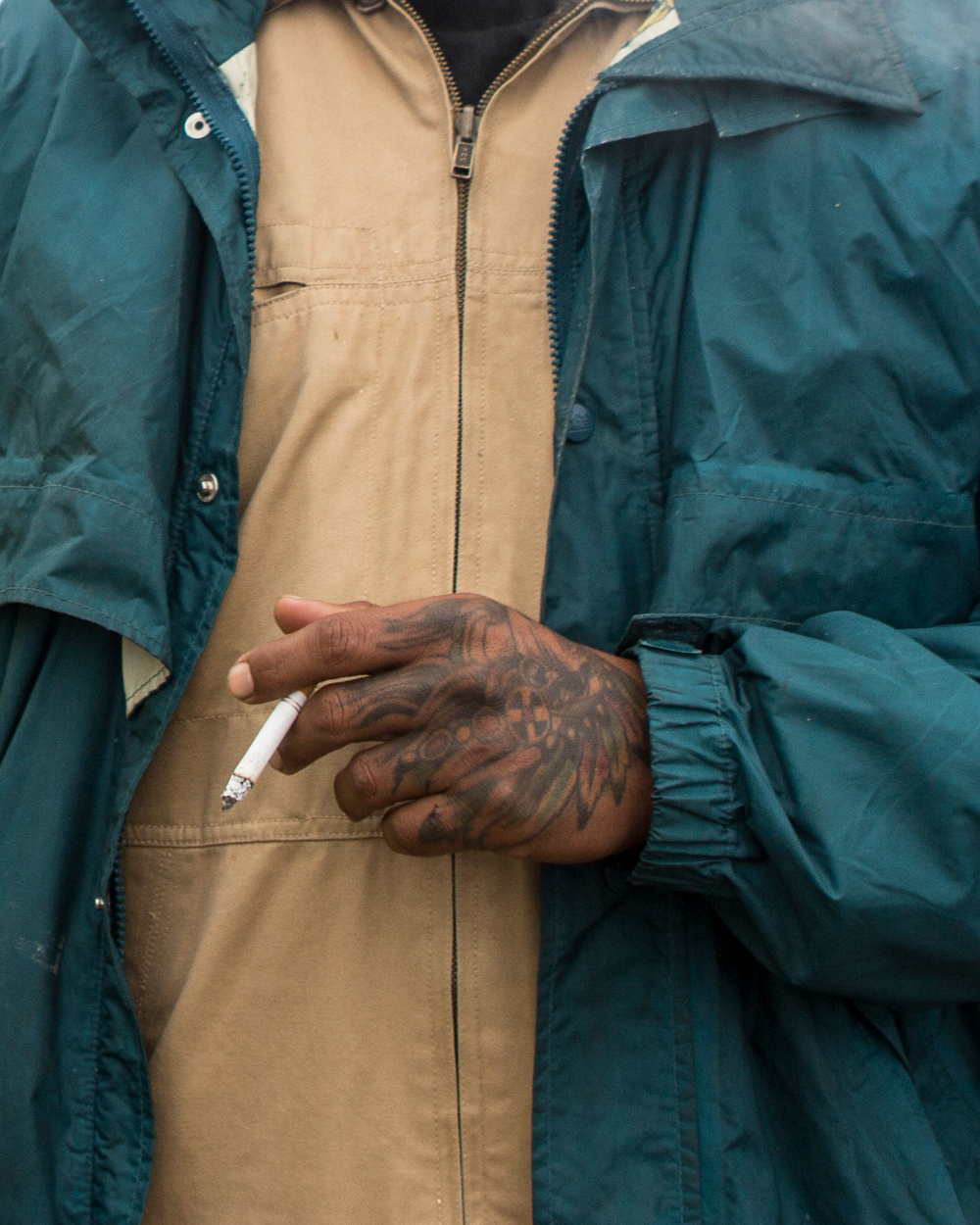 A similar idea was articulated by American Indian Movement co-founder Clyde Bellecourt one night at the main fire of Oceti Sakowin Camp, where he said that being in the camp itself was not simply a gathering of activists and protesters, but was a mode of prayer, and prayer itself was a mode of being. In a native context that has unfortunately become known for its high rates of alcoholism, drug abuse, suicide and domestic violence, the reality of bringing thousands of people together to create a safe, autonomous, self-organized drug and alcohol free zone of prayer and resistance is one of Standing Rock’s most politically potent contributions.
A similar idea was articulated by American Indian Movement co-founder Clyde Bellecourt one night at the main fire of Oceti Sakowin Camp, where he said that being in the camp itself was not simply a gathering of activists and protesters, but was a mode of prayer, and prayer itself was a mode of being. In a native context that has unfortunately become known for its high rates of alcoholism, drug abuse, suicide and domestic violence, the reality of bringing thousands of people together to create a safe, autonomous, self-organized drug and alcohol free zone of prayer and resistance is one of Standing Rock’s most politically potent contributions.
Within the occupation prayer becomes a way of marking the time by constantly reflecting on one’s actions and gestures with some form of recognition. As was remarked in the camp, “if you want to smoke a cigarette, don’t simply smoke it and flick the butt on the ground for someone else to clean up, but think of each cigarette as an offering of tobacco, as it was once sacred for us to do, as a prayer.” One of the guides for those receiving media accreditation to take photos at Standing Rock is not to film any ceremonies taking place, but this conception of prayer itself challenges the notion that such a thing is so clearly identifiable or recognizable, as any gesture, gathering, conversation could be invoked with such purpose and intentionality as to become imperceptible.
As of this writing, construction on the Dakota Access Pipeline in North Dakota is nearly complete, the exception being that which is slated to go under the Missouri River. The encampments and standoffs remain, as the Army Corps of Engineers and President Obama delay both intervention or approval for construction.
— for Clark Fitzgerald —
Source URL — https://roarmag.org/essays/standing-rock-no-dapl-protests/
Further reading
Is America ready for a municipalist movement?
- Alexander Kolokotronis
- November 27, 2016
The power of the movements facing Trump
- Michael Hardt, Sandro Mezzadra
- November 16, 2016


